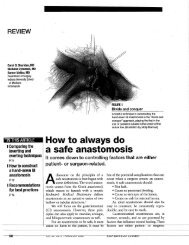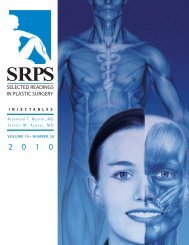SRPS PS - Plastic Surgery Internal
SRPS PS - Plastic Surgery Internal
SRPS PS - Plastic Surgery Internal
Create successful ePaper yourself
Turn your PDF publications into a flip-book with our unique Google optimized e-Paper software.
<strong>SR<strong>PS</strong></strong> Volume 10, Issue 25, 2009<br />
down to the germinal matrix, which is then left to<br />
close by secondary intention. 57,58 Alternatively, the<br />
entire proximal nail fold, including the cuticle, can be<br />
excised. 59 Once healed, a very satisfactory cosmetic<br />
result is achieved, although as the dorsal roof of the<br />
nail is ablated, the shiny surface layer of the nail is no<br />
longer produced. Complete removal of the nail and<br />
then treatment with a combined antifungal-steroid<br />
cream has also shown good results. 60 In cases of<br />
nonhealing chronic infection, malignancy should be<br />
ruled out considering that subungual melanoma often<br />
is unpigmented and mistaken for fungal infection. 61<br />
Pulp Space Infection (Felons)<br />
A felon is an infection of the pulp of the distal finger.<br />
The anatomy of the pulp is unique, with 1520<br />
longitudinal septa anchoring the tip to the distal<br />
phalanx (Fig. 5). 53 When infection is present, the septa<br />
can compartmentalize an infection and preclude<br />
adequate drainage if the septa are not fully ruptured.<br />
Figure 5. Anatomy of the fingertip. (Reprinted with permission<br />
from Conolly. 53 )<br />
Most felons are precipitated by some sort of<br />
penetrating trauma, and radiographs should be<br />
obtained of all felons and carefully evaluated for<br />
foreign bodies. If a felon does not respond to therapy<br />
or if strong evidence indicates that a non-radiopaque<br />
foreign body is embedded in the pulp,<br />
6<br />
ultrasonography might reveal a foreign body not seen<br />
on conventional radiographs. S. aureus is the most<br />
common pathogen in felons, 62 but gram-negative<br />
organisms have also been reported. Gram-negative<br />
organisms should be considered in immunosuppressed<br />
patients. A number of cases have been reported in<br />
diabetics who developed felons after checking their<br />
blood sugar level by fingerstick. 63<br />
If a pulp infection is observed early, it might<br />
simply be a case of localized cellulitis or a small<br />
superficial abscess. Localized cellulitis and small<br />
superficial abscesses can be treated with orally<br />
administered antibiotics, rest, and elevation or with<br />
local drainage as indicated. In a case of true felon, the<br />
patient presents with the entire pulp red, swollen, and<br />
markedly tender. The patient usually complains of a<br />
severe throbbing pain, particularly when the finger is<br />
dependent. The pain is caused by increased tissue<br />
pressure, which is caused by the unyielding septa<br />
(essentially a compartment syndrome of the pulp). At<br />
that stage, adequate drainage and antibiotics are<br />
required for treatment. 52,62 Late presentation or<br />
incomplete therapy can result in a compromise of the<br />
blood flow to the pulp, which can result in necrosis of<br />
the soft tissues, tenosynovitis, septic arthritis, and<br />
even osteomyelitis. 64<br />
Many incisions have been recommended for the<br />
drainage of felons. If it is pointing, the felon should be<br />
drained at that site. Careful palpation with a small<br />
blunt probe often determines a point of maximal<br />
tenderness, and the incision should be made at that<br />
site. The pulp must be explored immediately volar to<br />
the phalanx but dorsal to the neurovascular structures.<br />
The fibrous septa are ruptured to allow complete<br />
drainage of the infected space. Good results are<br />
achieved with a longitudinal midline palmar incision<br />
that does not cross the distal interphalangeal joint (Fig.<br />
6). 52,53 The incision heals well and usually does not<br />
produce a hypersensitive scar on the pulp.<br />
Tenosynovitis<br />
Tenosynovitis is an infection within the sheaths that<br />
form the gliding surfaces around the tenons in the<br />
hand. It is almost exclusively a disease of the flexor<br />
tendons, although extensor tenosynovitis at the level of<br />
the dorsal retinaculum has also been described. 65






